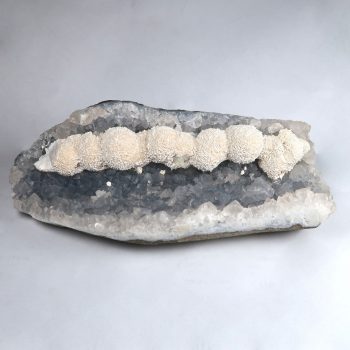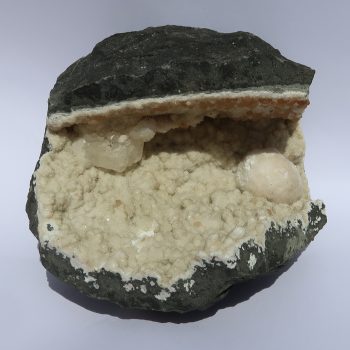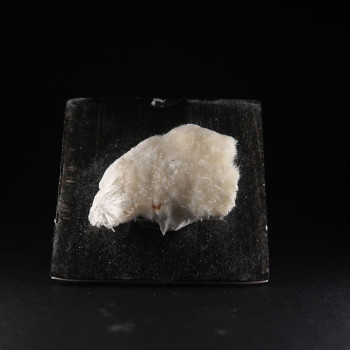Okenite
Okenite is a rare, silicate mineral that is composed of calcium, sodium, silicon, and oxygen. It was named after the German naturalist Lorenz Oken.
Okenite typically occurs as colorless or white, fibrous crystals, often in radiating clusters or tufts.
Showing all 3 results
-

Amethyst and Okenite display specimen
£80.00 -

Okenite and Gyrolite in Quartz geode
£200.00 -

Okenite from Malad Quarry, India
£7.50
Information about Okenite
Appearance
Okenite is an unusual mineral for sure – it looks, frankly, like a fluffy pom pom someone cut off a hat. It is a fibrous mass of radiating needle crystals, which form small balls.
Uses and History
Okenite has no industrial uses at all, as far as I can tell, however, due to its unusual appearance it is prized by mineral collectors. It is difficult to extract, which adds to both its value and rarity.
Okenite was described in 1828 and named after the German naturalist Lorenz Oken.
Locales
Africa:
Asia:
- Bombay Quarry, Mumbai Suburban District, Salsette Island, Konkan Division, Maharashtra, India
- Malad Quarry, Malad, Mumbai Suburban District, Salsette Island, Konkan Division, Maharashtra, India
- Nashik quarries, Nashik District, Nashik Division, Maharashtra, India
- Pune District, Pune Division, Maharashtra, India
- Vani-Dindori area, Dindori, Nashik District, Nashik Division, Maharashtra, India
Europe:
- Bramburg Quarry, Adelebsen, Göttingen District, Lower Saxony, Germany
- Queertarsuaq (Godhavn), Disko Island, Qeqertalik, Greenland
- Pervomaiskii quarry, Trudolyubovka, Bakhchysarai, Crimea, Ukraine
- Strond Quarry, Ánirnar, Borðoy, Norðoyar Region, Faroe Islands
- Valea Arsului quarry, Crișcior, Hunedoara County, Romania
- Zeilberg Quarry, Maroldsweisach, Haßberge District, Lower Franconia, Bavaria, Germany
South America:
Antarctica:
Australia and Oceania:
North America:
- Bingham Canyon Mine, Bingham Mining District, Salt Lake County, Utah, USA
- Goble, Columbia County, Oregon, USA
- Road 1449G, Elk Mountain, Toutle, Cowlitz County, Washington, USA
Mineralogy
Hazards and Warnings
Mineral collectors should wash their hands after handling specimens, to avoid any exposure to potential toxins.
Almost all rocks, minerals (and, frankly, almost all other substances on earth) can produce toxic dust when cutting, which can cause serious respiratory conditions including silicosis. When cutting or polishing rocks, minerals, shells, etc, all work should be done wet to minimise the dust, and a suitable respirator or extraction system should be used.
Translations
Arabic:
Hindi:
- ओकेनाइट
Portuguese:
- okenita
Bengali:
- ওকেনাইট
Indonesian:
Punjabi:
English:
- okenite
Italian:
Russian:
- Окенит
French:
Japanese:
- オケナイト
Spanish:
- okenita
German:
- Okenit
Korean:
- 오케나이트
Thai:
- โอเคไนต์
Gujurati:
- ओकेनाइट
Mandarin Chinese:
Urdu:
